Mouth guard do’s and don’t’s
With increased numbers of children and adolescents participating in a wide variety of sports, ensuring safety while encouraging athleticism paves a way for these young people to enjoy a lifetime of activity and, for some, competitive sports by reducing as much as possible the real risk of injury that can alter this trajectory with a single blow to the face.
With increased numbers of children and adolescents participating in a wide variety of sports, ensuring safety while encouraging athleticism paves a way for these young people to enjoy a lifetime of activity and, for some, competitive sports by reducing as much as possible the real risk of injury that can alter this trajectory with a single blow to the face.
Recommended: Caring for the student athlete
It is estimated that 30 million children in the United States participate in organized sports, and 46 million in some form of sporting activity.1 Of all dental injuries in children, 10% to 39% are caused by sports injuries with data showing that children aged between 7 and 11 years are the most susceptible to sports-related injury. The common types of orofacial injuries sustained include luxation injuries to tooth, avulsion, fracture of the facial bones, and concussion.2
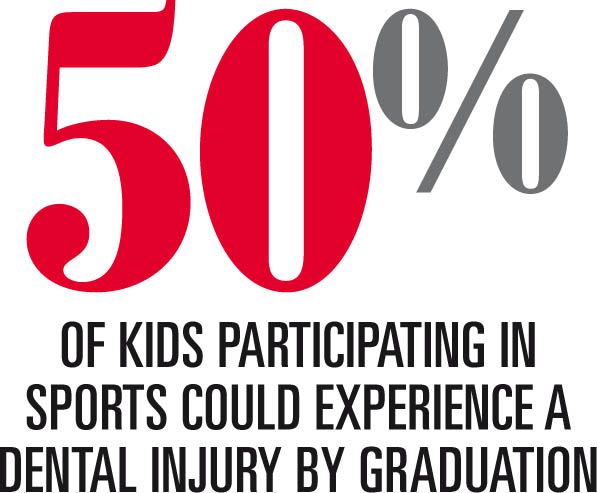
According to Mark Roettger, DDS, clinical associate professor, Department of Primary Dental Care, and medical director, University of Minnesota Physicians Dental Clinic, University of Minnesota Medical Center, Minneapolis, epidemiological data show that as many as 50% of kids participating in sports will experience a dental injury by the time they graduate from high school, and that the effect of these injuries can be lifelong and costly. For example, estimates for the cost of treating and providing follow-up for an avulsed permanent tooth range between $5000 to $20,000.3
In a study presented during a poster session at the 2014 American Academy of Pediatrics annual meeting, Roettger and co-investigator Jeffrey Karp, DMD, a pediatric dentist at the University of Minnesota, reported on an important tool to help reduce the frequent occurrence of orofacial injuries in student sports-the use of mouth guards.4 The study was done to educate pediatricians on the need for and use of mouth guards for children and adolescents who engage in sports. To that end, among the issues reported in the study was the evidence to date of the effectiveness of mouth guards to prevent orofacial injuries.
According to Roettger, data show that after mouth guards and face masks were implemented in the early 1960s in American football, injuries to the face and mouth fell from 50% prior to mouth guard use to less than 1% after.
More recent evidence from a 2007 meta-analysis by Knapik and colleagues that included data from 3 systematic reviews of the literature showed that the risk of an orofacial sports injury was 1.6 to 1.9 times higher when a mouth guard is not worn.5 Of note, the literature does not currently show the effectiveness of mouth guards to protect against concussion.6
Along with protection, some data is emerging suggesting that mouth guards may enhance performance and ongoing research is looking at the mechanisms behind this potential relationship.7 (See “Do mouth guards enhance performance?”)
Given the high frequency of orofacial injuries sustained by student athletes, and increasing evidence on the effectiveness of mouth guards to reduce these injuries, there is a strong need to educate parents, student athletes, coaches, and administrators on the value of mouth guards.
Pediatricians can play an important role in helping to get the word out. “If pediatricians get on board and help us in the dental area to educate parents and kids on the use of mouth guards, that’s a huge thing they can do,” said Roettger.
This article provides some important information for pediatricians to use when talking to parents and student athletes about the benefit of mouth guards.
NEXT: What are the current recommendations?
Current recommendations on mouth guard use
Currently, mouth guards are mandated by the National Federation of State High School Associations (NFHS) for student athletes who participate in football, field hockey, ice hockey, lacrosse, and wrestling (for wrestlers who wear braces).8
In addition, it is recommended by the Sports Medicine Advisory Committee of the NFHS that student athletes consider the use of mouth guards for any sport that may put the athlete at risk of orofacial injury, such as sports involving sticks, bats, and balls.8
More: Pediatricians are the gatekeepers of children's oral health
Further support of expanding the use of mouth guards in student athletes comes from the American Academy of Pediatric Dentistry (AAPD),1 which recommends mouth guard use for all youths engaged in competitive sports. In their policy statement on prevention of sports-related orofacial injuries, the AAPD cites several studies showing the frequency of orofacial injuries in a number of sports including basketball (most frequent incidence of dental injuries in adolescents aged 13 to 17 years) and baseball (highest incidence of sports-related injuries in children aged 7 to 17 years).1
The American Dental Association (ADA) also recommends broadening the use of mouth guards to include a wide range of sports (Table 14).9
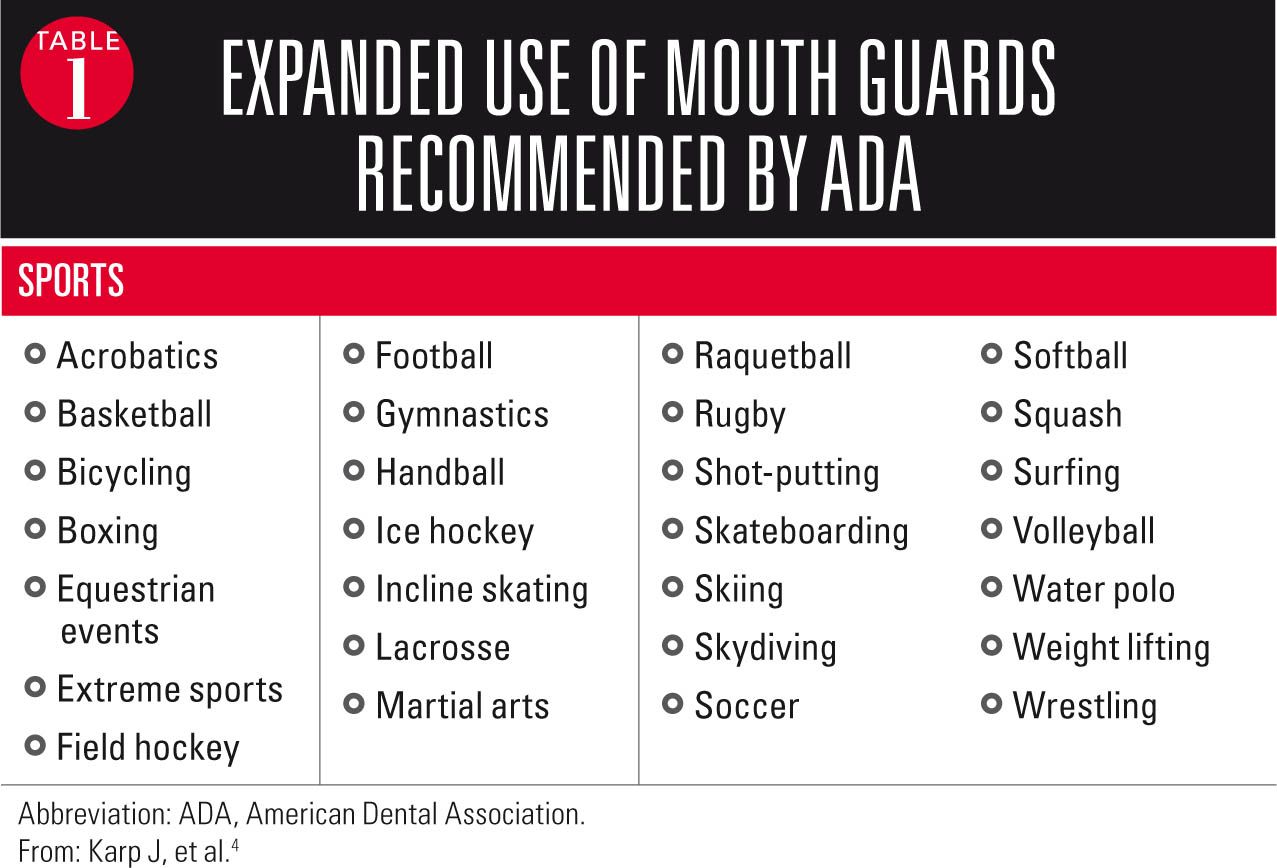
Despite these efforts to encourage broader use of mouth guards in children and adolescents engaged in sports, compliance with mouth guard use is less than 100% even when mandated and drops dramatically when not mandated, according to Roettger.
“If mandated, compliance is 75% to 85% among people who use mouth guards,” says Roettger. “If strongly recommended, however, the compliance rate falls to <10%, so a strong recommendation for use of mouth guards does virtually nothing.”
Given the large lack of usage that still remains, Roettger emphasizes that education is the key to increasing the use of mouth guards.
“If we just get parents to listen, they will make better choices,” he says, emphasizing that once the injury occurs it is too late and you have to deal with the repercussions.
NEXT: How to choose a mouth guard
Choosing a mouth guard
The first need is to educate parents and student athletes about the need for and compliance with mouth guards during sports. A further choice is to determine which type of mouth guard to choose. According to Roettger, features considered when choosing a mouth guard include fit and stability, speaking ability, protection, breathing, price, and ease of purchase. Table 21,10 lists the main types of mouth guards available, along with their features. As noted in the Table, the mouth guard that provides the most protection is the custom-fabricated mouth guard, and this is the type of mouth guard that the Academy for Sports Dentistry encourages.1
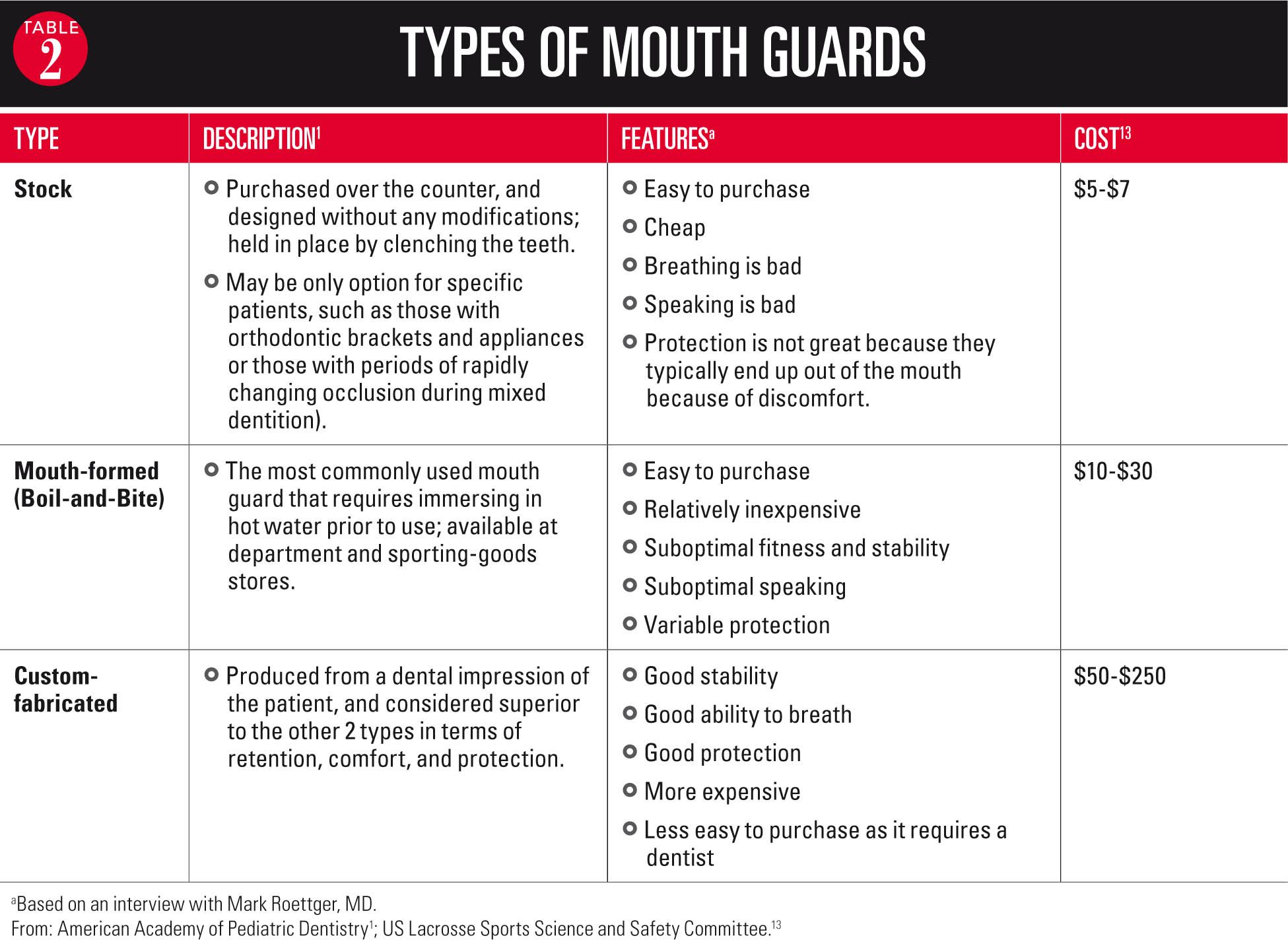
Of emphasis, however, when considering the type of mouth guard is to consider compliance. “The best mouth guard is one that is utilized during sports activities,” according to a statement by the ADA Council on Access, Prevention and Interprofessional Relations.11
Recommended: Don't overlook oral health in young children
In addition to choosing and using a mouth guard, adequate care is essential to ensure proper hygiene and reduce the chance of infection based on data showing an increased chance of infection with the use of mouth guards that can collect bacteria, yeast, and fungi (Table 3).12,13
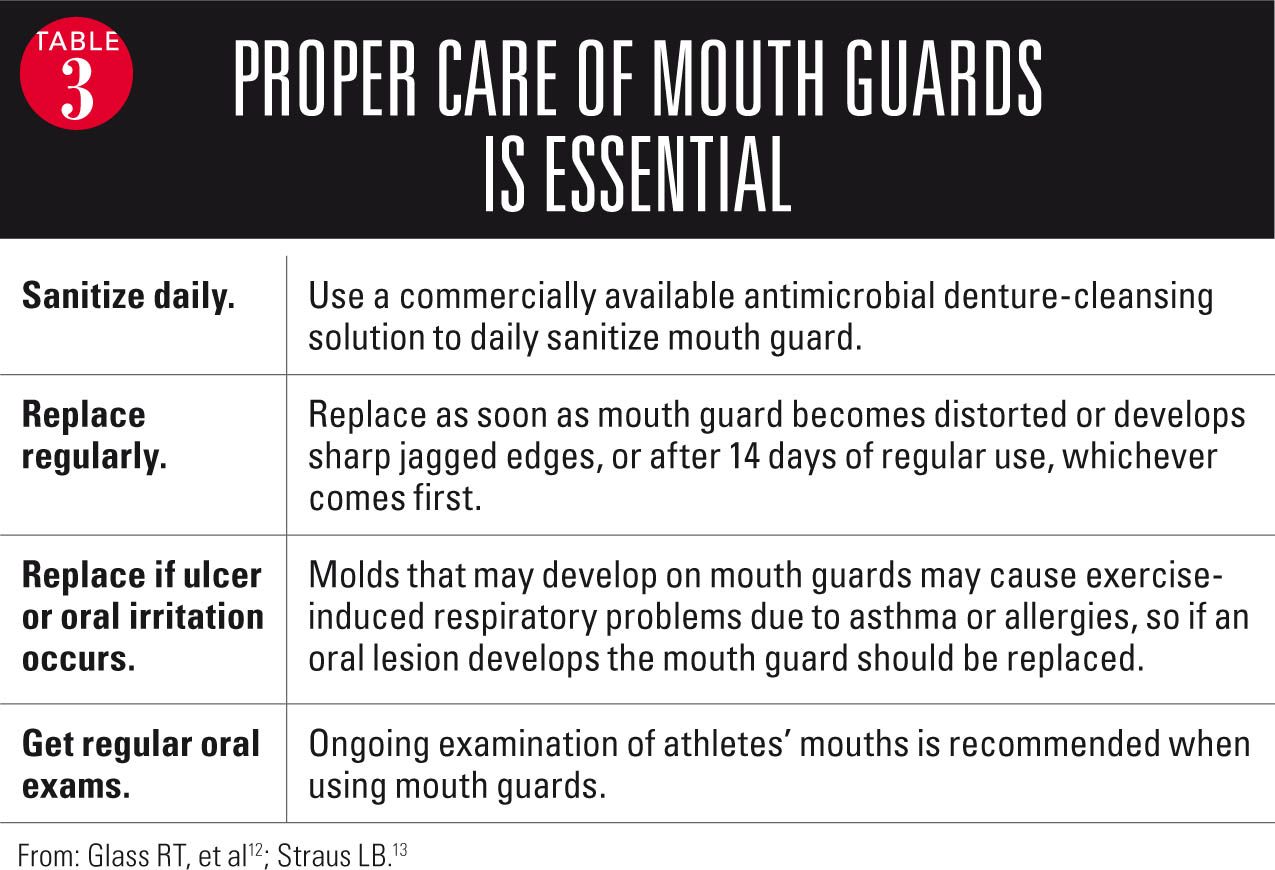
NEXT: Risk factors that predict injury
Risk factors predictive of sports injuries
Along with identifying children and adolescents who participate in sports in order to educate them on the merits of mouth guards, pediatricians should also be aware and recognize risk factors predictive of sports injuries in their patients to optimize prevention. For example, children with increased overjet and inadequate lip coverage experience a significantly higher frequency of dental traumas.1
Recommended: Oral and facial trauma
One way to consider these risk factors is to look at their extrinsic and intrinsic nature (Table 4).2 Extrinsic risk factors are independent of the individual and are related to the type of activity in a given sport. For example, people who run or jog are more likely to develop a stress injury. Other extrinsic risk factors include equipment worn, weather conditions affecting an athletic event, and quality of supervision. Intrinsic risk factors are related to the characteristics of individuals, including their biologic and psychosocial makeup that may predispose them to being injured during sports. Table 4 lists these intrinsic risk factors.
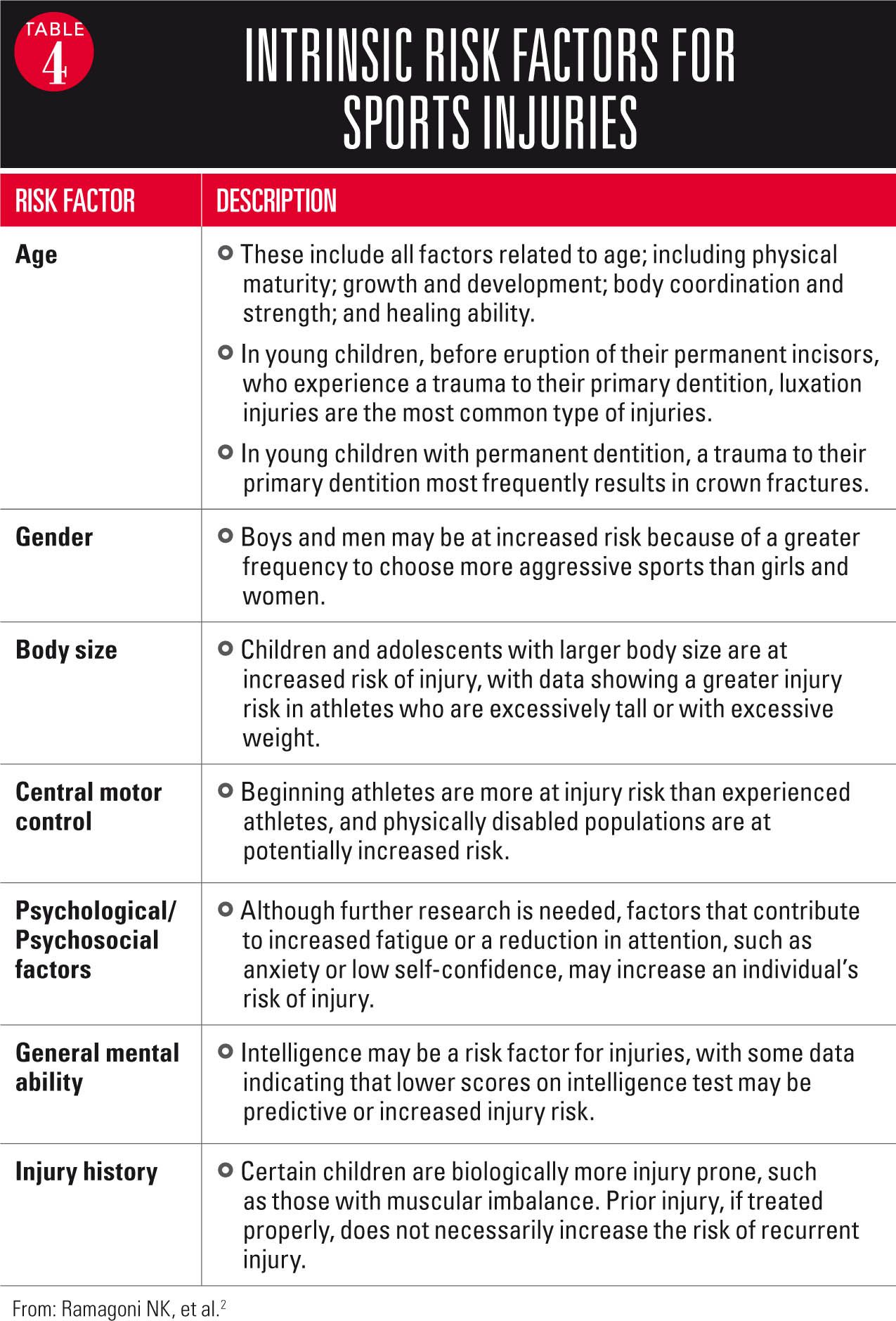
All these factors can help pediatricians assess a student athlete’s risk of sports injury, and can be useful when talking to the athlete and his or her parent about the importance of prevention and the use of mouth guards.
NEXT: Can mouth guards actually enhance performance?
Summary
With the increased participation by children and adolescents in athletics, ways to reduce the frequency of oral and facial injuries is emerging as a shared concern. The use of mouth guards in a variety of sports have reduced these injuries and subsequently are mandated for a select number of sports and recommended in others. Despite this, compliance is not great and many parents and student athletes remain unaware of the importance of mouth guards for prevention.
Pediatricians can play a vital role in educating parents and student athletes on the importance of using mouth guards and the relative advantages and disadvantages of the types of mouth guards currently available.
Along with providing protection, some data suggest that mouth guards also may improve performance, and ongoing research is under way to examine the mechanisms of this association.

REFERENCES
1. American Academy of Pediatric Dentistry. Policy on prevention of sports-related orofacial injuries. Oral Health Policies. 2013;36(6):67-71. Available at: http://www.aapd.org/media/Policies_Guidelines/P_Sports.pdf. Accessed July 22, 2015.
2. Ramagoni NK, Singamaneni VK, Rao SR, Karthikeyan J. Sports dentistry: a review. J Int Soc Prev Community Dent. 2014;4(suppl 3):S139-S146. Available at: http://www.ncbi.nlm.nih.gov/pmc/articles/PMC4304050/. Accessed July 22, 2015.
3. Most dental injuries in sports preventable, treatable. MomsTEAM website. Available at: http://www.momsteam.com/tmj/most-dental-injuries-in-sports-preventable-treatable. Published 2013. Accessed July 22, 2015.
4. Karp J, Roettger M. Mouthguard use during sports and recreational activities: what you need to know. Poster presented at: American Academy of Pediatrics National Conference and Exhibition; October 11-14, 2014; San Diego, California. Available at: https://aap.confex.com/aap/2014/webprogram/Paper25814.html. Accessed July 22, 2015.
5. Knapik JJ, Marshall SW, Lee RB, et al. Mouthguards in sport activities: history, physical properties, and injury prevention effectiveness. Sports Med. 2007;37(2):117-144.
6. McCrory P, Meeuwisse WH, Aubry M, et al. Consensus statement on concussion in sport: the 4th International Conference on Concussion in Sport, Zurich, November 2012. J Athl Train. 2013;48(4):554-575.
7. Garner DP, Dudgeon WD, McDivitt EJ. The effects of mouthpiece use on cortisol levels during an intense bout of resistance exercise. J Strength Cond Res. 2011;25(10):2866-2871.
8. National Federation of State High School Associations. Position statement and recommendations for mouthguard use in sports. Available at: https://www.nfhs.org/sports-resource-content/position-statement-and-recommendations-for-mouthguard-use-in-sports/. Updated November 21, 2014. Accessed July 22, 2015.
9. American Dental Association. The importance of using mouthguards: tips for keeping your smile safe. JADA. 2004;135:1061. Available at: http://www.ada.org/~/media/ADA/Science%20and%20Research/Files/patient_40.ashx. Accessed July 22, 2015.
10. US Lacrosse Sports Science and Safety Committee. Position statement on the use of mouthguards in lacrosse. Available at: http://www.uslacrosse.org/portals/1/documents/pdf/about-the-sport/statement-on-mouthguards.pdf. January 2010. Accessed July 22, 2015.
11. American Dental Association Council on Access, Prevention, and Interprofessional Relations. Oral Health Topics: mouthguards. Available at: http://www.ada.org/en/member-center/oral-health-topics/mouthguards. Published August 2008. Accessed July 22, 2015.
12. Glass RT, Conrad RS, Wood CR, et al. Protective athletic mouthguards: do they cause harm? Sports Health. 2009;1(5):411-415. Available at: http://www.ncbi.nlm.nih.gov/pmc/articles/PMC3445175/. Accessed July 22, 2015.
13. Straus LB. Mouth guards prevent dental injuries but require frequent replacement. MomsTEAM website. Available at: http://www.momsteam.com/health-safety/mouth-guards-prevent-dental-injuries-but-need-to-be-replaced-frequently. Updated August 22, 2013, Accessed July 22, 2015.
Ms Nierengarten, a medical writer in St. Paul, Minnesota, has over 25 years of medical writing experience, authoring articles for Lancet Oncology, Lancet Neurology, Lancet Infectious Diseases, and Medscape. She has nothing to disclose in regard to affiliations with or financial interests in any organizations that may have an interest in any part of this article.